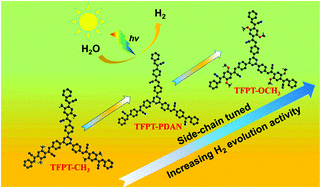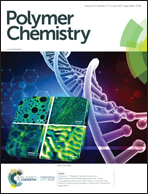Side-chain-tuned π-extended porous polymers for visible light-activated hydrogen evolution†
Abstract
Conjugated organic porous polymers featuring π-extended rigid frameworks with two or three dimensional structures are emerging as one new kind of promising semiconducting porous material suitable for electrochemical devices, magnetic materials, and photocatalysts. The construction of a porous polymer using full sp2-carbon linkages has been emerging as an attractive strategy to achieve π-delocalized skeletons with favorable stability. In this work, we report the synthesis of a series of fully sp2-carbon-linked conjugated organic porous polymers termed TFPT-CH3, TFPT-PDAN and TFPT-OCH3 by the Knoevenagel condensation reaction of 1,3,5-tris-(4-formyl-phenyl)triazine (TFPT) with 1,4-phenylenediacetonitrile derivatives. Their physical properties, such as visible light harvesting, band gaps and hydrophilicity, can be efficiently tailored via the variation of the side-chain substituents of building blocks. Accordingly, the as-prepared porous polymers exhibit visible light-driving photocatalytic activity for water-splitting hydrogen evolution with excellent stability and reusability. Of these, the porous polymer TFPT-OCH3 with methoxyl side-chain substituents exhibits the best photocatalytic behaviour with an apparent quantum yield up to 1.03% at 405 nm. This work provides a valuable approach to improve the photocatalytic water-splitting activity of porous polymers through a simple side-chain modification strategy.



 Please wait while we load your content...
Please wait while we load your content...